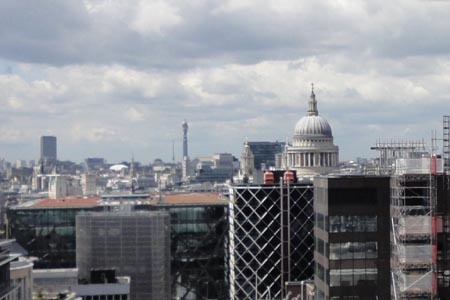Mystery Worshipper: Cantate Domino
Church:
St Paul's Cathedral
Location: City of London
Date of visit: Sunday, 31 July 2011, 3:15pm
The building
Where does one start? There has been a church on Ludgate Hill since at least 604, the original humble structure supplanted by a mighty Romanesque and Gothic cathedral that in turn perished in the Great Fire of London in 1666. Christopher Wren, after numerous controversies with the dean and chapter over design, completed the current cathedral by 1710. The massive domed structure is surely one of the top five buildings in England, a symbol of London and the burial place of Nelson and Wellington. Grand without being grandiose, dignified without being cold, it is Wren's masterpiece and an architectural triumph.
The church
St Paul's serves the same function it has since the early Middle Ages, as the cathedral church of the diocese of London. There are services held every day, many of them supported by the renowned choir of men and boys, and it is the spiritual focus of the diocese.
The neighborhood
St Paul's neighbourhood is the City of London's square mile. Nearby is what remains of Paternoster Row and the ruins of St Augustine's Church and Christchurch, all victims of the Blitz, which St Paul's so fortuitously survived. While the City remains a financial centre, other aspects of the neighbourhood have changed in recent years. For example, nearby Fleet Street is no longer home to the British metropolitan newspapers. Local landmarks within walking distance include the Stock Exchange and the Bank of England, plus the survivors of Wren's 50 churches rebuilt after the Great Fire. There is almost no resident population in the City of London.
The cast
The Rt Revd Graeme Knowles, dean; the Rt Revd Michael Colclough, pastor (both of whom are bishops); the Revd Canon Michael Hampel, precentor; the Revd Andrew Hammond, succentor, who preached; and the cathedral virgers.
What was the name of the service?
Evensong with the Installation of the Dean's Virger.How full was the building?
There were perhaps 200 actually seated, filling the space under the dome. Many more tourists were standing listening at the west end.
Did anyone welcome you personally?
I was conducted to a seat by a sequence of wandsmen, resplendent in tailcoats.
Was your pew comfortable?
A modern seat, perfectly comfortable for an hour's evensong.
How would you describe the pre-service atmosphere?
Very noisy, what with a large congregation jostling for seats and many more tourists moving through the building.
What were the exact opening words of the service?
"Welcome to St Paul's."
What books did the congregation use during the service?
A printed order of service, including the words for the brief ceremony of the installation of the dean's virger and the standard 1662 order of service for evening prayer.
What musical instruments were played?
St Paul's mighty organ, played in the past by Handel and Mendelssohn. The current instrument is the fifth largest in Great Britain and is housed in a case by the late 17th/early 18th century sculptor and woodcarver Grinling Gibbons. The Aurora Nova vocal ensemble, who in 1997 were the first professional all-female choir ever to sing at a service in St Paul's, also took part.
Did anything distract you?
The entire building is a distraction. The mosaics in the vaults, the paintings by the English baroque artist James Thornhill in the dome, the monuments to the great and good, the metal screens by the French Huguenot ironworker Jean Tijou, the splendid stone carving. Everywhere there is something to delight the eye.
Was the worship stiff-upper-lip, happy clappy, or what?
The service was dignified and solid cathedral worship. There was, of course, minimal congregational participation besides two hymns and saying the creed and the occasional "Amen". The new dean's virger was ceremonially presented with his virge, or brass wand of office, by the dean, while the congregation prayed that he would execute his duties well.
Exactly how long was the sermon?
10 minutes.
On a scale of 1-10, how good was the preacher?
6 – The succentor is a decent speaker; it was just the content that gave pause for thought (see below).
In a nutshell, what was the sermon about?
This was quite an extraordinary sermon, during which the succentor recounted for us aspects of his troubled life, including coming close to being expelled from school. I am not sure what the message was, but the level of self-disclosure was really too much information. Also, referring to the new dean's virger as "loyal" and "faithful" did make him sound like a particularly fine gundog.
Which part of the service was like being in heaven?
The experience of worship in St Paul's is deeply moving. Using words from a prayer book that have been hallowed by their centuries of use, in a building so magnificent and so special to so many people, cannot fail to be heavenly.
And which part was like being in... er... the other place?
The settings of the canticles were ones that I had heard used back home in Brisbane. They were not to my liking then and were not so now.
What happened when you hung around after the service looking lost?
There is an entry fee for St Paul's, except for services, so all the congregants were firmly and efficiently escorted out the north door, lest we should get to see the cathedral for free by wandering around after the service!
How would you describe the after-service coffee?
There was none on offer.
How would you feel about making another visit (where 10 = ecstatic, 0 = terminal)?
10 – I could come back anytime.
Did the service make you feel glad to be a Christian?
Very much so.
What one thing will you remember about all this in seven days' time ?
The entire experience of worship in this very special cathedral.
